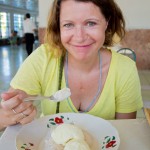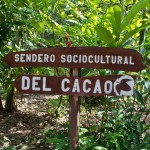For those of you who have been following my adventures around the world for the last 8 months, you know that I have been to Europe, Africa, Asia and Mexico in search of chocolate knowledge. Despite going to all of these places, I feel like my holy grail has still eluded me. I had tasted the best chocolate in the world, the most expensive chocolate in the world, the most ancient chocolate in the world and yet I had not found what I was looking for. Until I came to Cuba, that is. My answer has arrived, but not in learning what chocolate is, but rather what it isn’t.
 Chocolate is undeniably a food, and in a Cuba, food establishments are mainly government run (by the Ministry of Gastronomy or something like that). The food and drink on all menus are dictated by and supplied by the bureaucrats in the Cuban government. Thus the chicken sandwich on the menu is going to be the same as all the chicken sandwiches on all the menus across the country. The same is true for the coffee, the bread, and the chocolate. Our travels across the food wasteland of Cuba ended in the eastern Cuban town of Baracao, where cacao is grown and turned into chocolate in a factory started by
Chocolate is undeniably a food, and in a Cuba, food establishments are mainly government run (by the Ministry of Gastronomy or something like that). The food and drink on all menus are dictated by and supplied by the bureaucrats in the Cuban government. Thus the chicken sandwich on the menu is going to be the same as all the chicken sandwiches on all the menus across the country. The same is true for the coffee, the bread, and the chocolate. Our travels across the food wasteland of Cuba ended in the eastern Cuban town of Baracao, where cacao is grown and turned into chocolate in a factory started by  Che Guevara. It is also supposed to have the best food in Cuba. There is a cafe in town called “Casa del Chocolate” where you could get hot chocolate made from the cocoa powder produced by this factory. We went after lunch one day and ordered one of each of the three things on the menu: Hot chocolate, chocolate pudding, and coconut ice cream. The ice cream was excellent, but the chocolate pudding and the hot chocolate were terrible. Ilona described the hot chocolate as dull and boring. The closest thing I can compare it to is wallpaper glue. Without question, this was the worst hot chocolate I have ever tasted, yet we were in the heart of Cuba’s cacao growning region.
Che Guevara. It is also supposed to have the best food in Cuba. There is a cafe in town called “Casa del Chocolate” where you could get hot chocolate made from the cocoa powder produced by this factory. We went after lunch one day and ordered one of each of the three things on the menu: Hot chocolate, chocolate pudding, and coconut ice cream. The ice cream was excellent, but the chocolate pudding and the hot chocolate were terrible. Ilona described the hot chocolate as dull and boring. The closest thing I can compare it to is wallpaper glue. Without question, this was the worst hot chocolate I have ever tasted, yet we were in the heart of Cuba’s cacao growning region.
Later that week we did have great hot chocolate. It was made by a local woman who roasted her own cacao and made her own coconut milk from scratch. This traditional drink is called “chorote”, and it was fantastic. We also had coco fish, our best meal in Cuba, at one of the few privately owned restaurants in Baracoa. This is another example of how independent initiative can beat out government-run food establishments in Cuba.

In the town of Cienfuegos, we stopped at the national ice cream chain called Coppelia. Coppelia is famous for its lines, because this is the place where Cubans come to get their ice cream. We waited for 15 minutes until we were seated and then another 15 before our order was taken (shorter than average, perhaps because we were in Cienfuegos, not Havana). There were 2 flavors that day and we chose one of each. While we waited, I couldn’t help but observe the atmosphere in the place, which was very somber and serious. Each Cuban ordered around 6 scoops, which cost about 80 cents (US). When the ice cream arrived, in Chinese porcelain soup bowls, everyone began eating noislessy. Stranger still, was that people began scooping leftover ice cream into empty plastic containers to eat later at home (melted or perhaps refrozen).

 I was struck by a feeling of sadness and pity for these people. It seemed fundamentally wrong that the simple pleasure of going out for ice cream on a whim was denied them. Even though it’s possible to get ice cream at places other than Coppelia in Cuba, the cost makes it a luxury usually accesilble only for tourists or some of the few well connected Cubans. The formality of the ceramic bowls, and the take home ice cream containers somehow said it all: You can indulge in ice-cream, but you can’t *spontaneously* indulge.
I was struck by a feeling of sadness and pity for these people. It seemed fundamentally wrong that the simple pleasure of going out for ice cream on a whim was denied them. Even though it’s possible to get ice cream at places other than Coppelia in Cuba, the cost makes it a luxury usually accesilble only for tourists or some of the few well connected Cubans. The formality of the ceramic bowls, and the take home ice cream containers somehow said it all: You can indulge in ice-cream, but you can’t *spontaneously* indulge.
Then it struck me that the pleasure we get from food is as much about getting what you want when you want it, as it is about getting what’s good. For me, great chocolate is essential for happiness because the pleasure I get from eating it allows me to be free of my worries and concerns, if even for a few delicious moments. Perhaps having the choice to have what we want when we want it is equally important as the taste of the food.
 Then I got it: You can’t have true pleasure without freedom and freedom means being able to choose what to indulge in, when to indulge, and where to indulge. Freedom is knowing that you are being naughty (or just living, if you are French) but chosing to do it anyway.
Then I got it: You can’t have true pleasure without freedom and freedom means being able to choose what to indulge in, when to indulge, and where to indulge. Freedom is knowing that you are being naughty (or just living, if you are French) but chosing to do it anyway.
Back at the Casa del Chocolate, it struck me that free enterprise has some advantages: it spurs the pursuit of excellence. Competition between people to make a better product really creates better products. The government should not be in the business of managing personal pleasure. Governments should stick to building solid roads and collecting taxes. When it comes to chocolate, just “getting it done on time and under budget” is not enough.
On the flight out of Cuba, we got more of that bad Cuban chocolate on our dinner tray. I tossed mine and opened instead the bag of M&M peanuts that I picked up at the airport before boarding the plane. Normally I dismiss commercial candy bars as being overly sweet and tasteless (which they are compared to fine chocolate), but this time I relished each and every one. My pleasure from eating them came not only because they tasted better than the Cuban stuff, but also because I chose to buy them and I chose to eat them. It was my decision to be naughty.
I tossed mine and opened instead the bag of M&M peanuts that I picked up at the airport before boarding the plane. Normally I dismiss commercial candy bars as being overly sweet and tasteless (which they are compared to fine chocolate), but this time I relished each and every one. My pleasure from eating them came not only because they tasted better than the Cuban stuff, but also because I chose to buy them and I chose to eat them. It was my decision to be naughty.








Hey Kerstin,
Really miss you all and your “little shop of heavenly chocolate delights”.
When I drive by and see the sign, I get a bit of a rush… ohhh their back…
however, alas it isn’t so.
Really enjoy the new blog and the photos are great.
On your reflection of Cuba and your epiphany, I couldn’t agree more. I came to a similar conclusion while traveling overseas and reading Ayn Rand’s Atlas Shrugged many years ago.
Cheers
Larry C.
Well said!!!